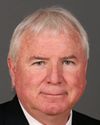Mr. Chairman, members of the committee, thank you for your clear demonstration of interest in the air force's involvement in supporting Canadian Forces operations in Afghanistan and for inviting me here to speak with you today about our significant contribution in the campaign against terrorism and in helping to build a new democracy in the region.
Thank you for your clear demonstration of interest in the Air Force’s involvement in supporting Canadian Forces operations in Afghanistan, and for inviting me here to speak with you today about our significant contribution in the campaign against terrorism and in helping to build a new democracy in this region.
As I begin, I would like to first acknowledge the tremendous job that our army is doing in Afghanistan. While members of all elements of the Canadian Forces are contributing in Afghanistan, it is truly the army that is carrying the greatest part of the load in carrying out this operation.
Today I'd like to take this opportunity to focus on three elements of our support to the operation. First is the lifeline that the air force is providing to Canadians serving in Afghanistan. Second are the in-theatre tactical operations involving combat resupply and the operation of unmanned aerial vehicles for intelligence, surveillance, and reconnaissance. Finally are other significant contributions that individual air force personnel are making in support of NATO, the Government of Afghanistan, and its integrated members of Joint Task Force Afghanistan.
At home, as you are aware, the Air Force has focused its efforts on Canada’s top defence priority: the no-fail mission of protecting Canada first.
Whether guarding our vast skies, patrolling the longest coastline in the world, providing immediate response to Canadians in distress through our search and rescue network, or working with other government departments, being prepared to respond to threats to Canadians is job number one for the Canadian Forces and the air force.
In addition, the air force continues to be engaged in many other operations around the world, including the current Canadian Forces operation in Afghanistan. There, we are working alongside the army in an effort to create a safe and secure environment for the growth of democracy in Afghanistan.
Let me begin with my first point: the lifeline the air force provides to Joint Task Force Afghanistan.
Canada’s Air Force has been engaged in the campaign against terrorism, continuously supporting Canadian Forces operations in Afghanistan and this region, since 2002.
Today, strategic airlift bridges the considerable distance between Canada and Southwest Asia, halfway around the world.
Together with our tactical inter-theatre airlift, between our staging area at Camp Mirage and Kandahar, the air force provides a lifeline to the members of the Canadian Forces operating in Afghanistan. This air bridge requires absolute dedication to ensure it operates effectively, because, as has been often stated by General Hillier, the very success of the mission in Afghanistan depends on it.
Over the past 12 months, over 550 chalks of strategic airlift, representing the movement of thousands of people and tonnes of materiel, have supported our joint task force in Afghanistan.
Our fleet of five CC-150 Polaris Airbus aircraft has been used largely for personnel transport and for smaller pallet-sized cargo. The majority, almost 75% of the strategic airlift, however, has been accomplished through contracted airlift, including C-17 chalks provided by the United States Air Force.
The materiel and personnel are first flown into Camp Mirage, the primary Canadian base of operations in the theatre. Camp Mirage is also used to administer personnel departing and returning from Afghanistan during periods of home leave travel assistance or rest and recreation.
Camp Mirage is commanded by a Canadian Air Force lieutenant-colonel and is operated almost exclusively by air force personnel. Thousands of air force personnel have quietly served in Camp Mirage since it was first established in 2002.
Currently, the newly formed 17 Mission Support Squadron from 17 Wing Winnipeg, Manitoba, is providing the bulk of the support personnel serving at Camp Mirage. The creation of mission support squadrons is part of the continuing transformation of the air force into a more effects-based expeditionary air force.
14 Mission Support Squadron from 14 Wing Greenwood, Nova Scotia, is currently training for their deployment into Camp Mirage in the near future.
Given the current air threat and risk assessments in theatre, the CC-130 Hercules remains the sole platform for moving personnel into Afghanistan from our staging base at Camp Mirage. The Hercules, about one-third to one-quarter the size of the strategic lift aircraft, is the workhorse of our air mobility fleet. Over the past 12 months, they have made over 500 flights into Afghanistan.
This brings me to my second point, the air force's in-theatre tactical operations.
Air and ground crew are conducting flying operations with the CC-130 Hercules throughout Afghanistan in direct support of Canadian Forces operations in that country. Whether transporting personnel from Kandahar to Kabul or parachuting up to 14,500 kilos of supplies per flight to deployed soldiers throughout the country, they are making a tremendous difference.
They have become a key enabler to commanders by providing supplies to soldiers throughout portions of Afghanistan that are not supported by a good road network, or in areas in which the Taliban are disrupting the road network.
In addition to supporting Canadian soldiers, they have been instrumental in delivering personnel and supplies for other nations, including the Netherlands, the United Kingdom, and the United States. They are being acknowledged by other nations for their accuracy and effectiveness, particularly when it comes to air-dropping supplies into dangerous and hostile environments.
The air force also has responsibility for generation and provision of unmanned aerial vehicle or UAV capability for Joint Task Force Afghanistan. Air force and army personnel work together in an integrated tactical UAV unit, providing invaluable intelligence surveillance and reconnaissance support to commanders in the field. That information is proving to be fundamental to achieving tactical success for the soldiers on the ground, providing them with greater situational awareness that contributes directly to reducing risk while they carry out the missions.
Lastly, I would like to bring to your attention other significant contributions being made by individual air force personnel in Afghanistan.
Men and women of the air force are also actively engaged in key positions within NATO's ISAF headquarters in Kabul. In fact, my former deputy, a Canadian Air Force general, Major-General Angus Watt, is the deputy commander of ISAF and takes over responsibility for running ISAF's missions during the commander's absences from theatre.
Other Canadian Air Force personnel, including members of my headquarters, have been instrumental in Kabul by helping the Afghan government as members of the Canadian Strategic Advisory Team.
This team was established under the direction of General Hillier, at the request of Afghan President Karzai, to bring to the Government of Afghanistan two main areas of expertise: strategic planning and capacity building. The 17-member team works directly within the central Government of Afghanistan and is currently headed by an air force officer, Colonel Don Dixon.
In addition, airfield engineers and other skilled Air Force personnel are integrated into a variety of units, filling critical roles in the Canadian areas of operations in and around Kandahar.
My role in this as Commander of Air Command and Chief of the Air Staff is to generate combat-ready air forces for deployment and employment. This involves the training of personnel and ensuring they have the right equipment to do the jobs asked of them. This is why we are working so hard at acquiring a fleet of four C-17s for strategic airlift and replacing the tactical air fleet of aging Hercules with more modern aircraft.
In addition to providing combat-ready forces for current operations, we're always conducting and reviewing contingency plans in order that the air force remains prepared to further contribute, if and when the need arises.
In conclusion, I'd like to reinforce that without the air bridge, the lifeline from our bases in Canada to Camp Mirage and onward into Kandahar and Kabul, the mission could not succeed. The invaluable missions being performed by the men and women at the air force in theatre are integral to the conduct of Canadian Forces operations in Afghanistan. I can assure you that you can be very proud of what they're doing on behalf of this country and all Canadians under dangerous and difficult conditions. I will be reinforcing that message when I visit our troops in a couple of weeks.
Mr. Chairman, messieurs, mesdames, membres du comité, I would be happy to answer any questions you may have following remarks by my colleague, the Chief of Maritime Staff, Vice-Admiral Drew Robertson.





